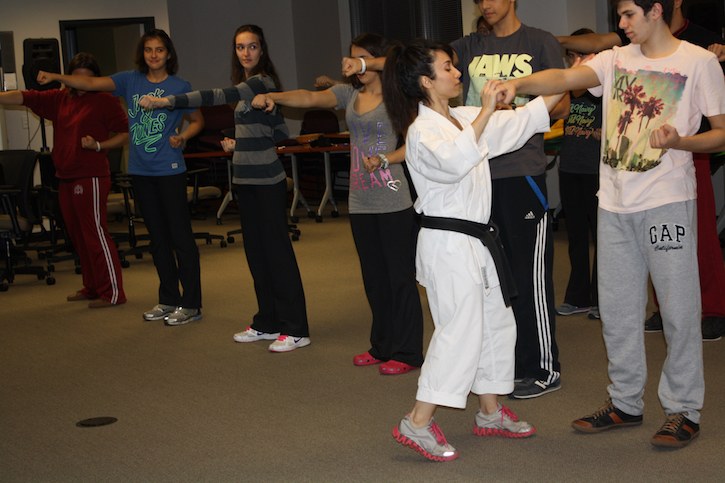
Soolmaz Aboali Teaching Karate to Students
By Soolmaz Abooali
The ‘Ping-Pong’ diplomacy case is an historic incident of how sport was leveraged to carve an opening in US-Sino relations in the 1970s after approximately two decades of stalemate between the two nations. The notion that sport could be used as a vehicle to address social and political conflicts has since grown in breadth. In today’s era, sport is not only fueled by the power of public media but it is also increasingly leveraged by entities such as governments, non-governmental and international organizations, and academic institutions for its ability to promote tolerance and respect. For example, there currently exist 458 registered Sport for Development and Peace (SDP) related non-governmental organizations around the world, a marked consistent increase from 295 in 2011 and 145 in 2008. In the past decade, the United Nations (UN) has solidified its support of sport for development purposes, pointing to its “contributions to the empowerment of women and of young people, individuals and communities as well as to health, education and social inclusion objectives.”
In August 2013, the UN proclaimed April 6 as the International Day of Sport for Development and Peace to mark the potential and usage of sport in such capacities. To help commemorate this day, George Mason University took the opportunity on April 6, 2017 to announce its unique commitment to expanding the breadth and depth of the SDP field. Through a partnership between the School for Conflict Analysis and Resolution and the Sport Management program, students will have the opportunity to study and learn more about sport as it relates to addressing conflict. The ‘Sport and Conflict Resolution’ minor, and a semester-long Sport Diplomacy class, will be offered in the fall of this year with the aim to deepen both the understandings and skills of those who wish to create positive changes at multiple levels of society through sport.
In a new book, Case Studies in Sport Diplomacy, edited by Michael Sam, Steven Jackson, and Mason's own Craig Esherick and Robert Baker, we are able to get an in-depth viewpoint into this topic. The text explores the influence and effectiveness of sport in “improving long-term relations between nations by opening a dialogue with international leaders, raising awareness of host countries and to bridging cultural differences, and in building international relationships through ambassadors that could increase trade and legislative agreements, and even bring peace to nations in conflict.”
Athletes themselves can indeed serve as agents in these various areas. We have only to look at recent notable examples led by present-day athletes such as NFL player Colin Kaepernick, NBA player Stephen Curry, ballet dancer Misty Copeland, and fencer Ibtihaj Muhammad to see how their platform can be leveraged to highlight grievances and advocate change. Moreover, the bonding that can occur between athletes is yet another equally unique component, and something to which I can attest. Traveling around the world to represent the US in Traditional Karate, the only language my competitors and I spoke was that of the martial arts. It was the glue that brought us together in the same space and our experiences there had ultimately initiated a desire to want to learn more about the “Other.” If anything, those experiences gave me the chance to observe how accurately my own worldview represented the “Other.” Oftentimes, I found that my fellow competitors were just as human as I; we were separated only by how our respective societies had shaped our perceptions. Such connections and interactions between athletes is another facet of sport that is discussed in Case Studies in Sport Diplomacy, specifically those related to wrestlers from two historically estranged nations – the United States and Iran.
Sport has been shown to present a unique option in bringing people together, and when leveraged appropriately, it can form the beginnings of strong bonds upon which other substantive topics of interests can be discussed.
Programs and resources that analyze such non-traditional methods are more necessary today than they were in 1970s during the Ping-Pong diplomacy era. And George Mason University, with its diverse knowledge base and prime location near the nation’s capital, is well positioned to be taking on the growing field of sport.
